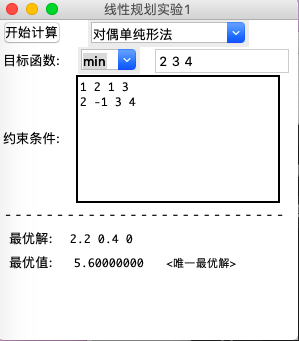Programming Realization of Simplex Method (Part 2)
Previously: https://blog.csdn.net/nanashi_F/article/details/95891827
3. python Programming of Dual Simplex Method (Basically Simplex Method)
Step1: Simplex table class (shared with simplex method, abbreviated)
Step2: Iterative Function
def Iteration2(self): #Iterative function lim=100 #Maximum number of iterations (to prevent infinite iterations without solutions) while(lim>0): self.check=[] for i in range(self.X_num): #Calculate the number of tests temp=0 for j in range(self.B_num): temp+=self.bound[j][i]*self.z0[self.Xbase[j]] self.check.append(self.z0[i]-temp) self.IsEnd() #Judging whether the iteration is over if self.flag>0: #If there is a solution, the iteration ends. break else: #Otherwise, base transformation is performed. self.BaseChange(2) lim-=1
Step3: Judging Iterative Termination Function
def IsEnd2(self): self.flag=1 for i in range(self.B_num): if self.bound[i][self.X_num]<0: #If the constrained right-hand constant is negative, continue iterating self.flag=0 break
Step4: BaseChange Function and Simplex Method
def FindMain2(self): #Finding the Main Element iB=[] for i in range(self.B_num): iB.append(self.bound[i][self.X_num]) iout=iB.index(min(iB)) #Get the minimum value ordinal number in b theta=[] for j in range(self.X_num): if self.bound[iout][j]>=0: th=1000 elif self.check[j]==0: th=1000 else: th=self.check[j]/self.bound[iout][j] theta.append(th) iin=theta.index(min(theta)) #Get the minimum value serial number in the number of tests main=self.bound[iout][iin] return [iout,iin,main]
IV. Input-python Form Program
Code
#!/usr/bin/python # -*- coding: utf-8 -*- import LPTable from tkinter import * from tkinter import ttk def Start(): model=comboxlis.get() #Getting Simplex Types if model=="simplex method": model1() elif model=="Dual Simplex Method": model2() else: text31.insert("end","Choose a computing model") def model2(): Table=ReadData2() Table.Iteration2() #Enter Iteration if Table.flag>0: #Determine whether the optimal solution is obtained by iteration z=0 #optimal value Best=[] #optimum solution for j in range(Table.X_num-Table.B_num): Best.append(0) for i in range(Table.B_num): X=Table.Xbase[i] c=Table.z0[X] num=Table.bound[i][Table.X_num] Best[Table.Xbase[i]]=num #Recording Optimal Solution z+=num*c #Arrange the Optimum Value text41.insert("end",Best) z=-z #Minimum conversion text51.insert("end",str(z)) if Table.flag==1: text52.insert("end","<Unique Optimal Solution>") else: text52.insert("end","<Alternative optimal solution>") else: text52.insert("end","<No Optimal Solution>") def model1(): [Table,Mtype]=ReadData() #Obtaining data Table.Iteration() #Enter Iteration if Table.flag>0: #Determine whether the optimal solution is obtained by iteration z=0 #optimal value Best=[] #optimum solution for j in range(Table.X_num-Table.B_num): Best.append(0) for i in range(Table.B_num): X=Table.Xbase[i] c=Table.z0[X] num=Table.bound[i][Table.X_num] Best[Table.Xbase[i]]=num #Recording Optimal Solution z+=num*c #Arrange the Optimum Value text41.insert("end",Best) if Mtype=="min": #Minimum conversion z=-z text51.insert("end",str(z)) if Table.flag==1: text52.insert("end","<Unique Optimal Solution>") else: text52.insert("end","<Alternative optimal solution>") else: text52.insert("end","<No Optimal Solution>") def StrChange(sstr): #Converting strings to list storage lst=sstr.split(' ') new=[] length=len(lst) for i in range(length): new.append(float(lst[i])) return [new,length] def ReadData2(): #Read data text41.delete("1.0","end") text51.delete("1.0","end") text52.delete("1.0","end") [z0,X_num]=StrChange(entry21.get()) for i in range(X_num): #Transform objective function z0[i]=-z0[i] IB=text31.get("1.0","end").split('\n') B_num=len(IB)-1 bound=[] #constraint condition for i in range(B_num): bound.append(StrChange(IB[i])[0]) for j in range(X_num+1): bound[i][j]=-bound[i][j] Xbase=[] for i in range(B_num): #Add artificial variables Xbase.append(X_num+i) z0.append(0) b=bound[i].pop(-1) for k in range(B_num): if k==i: bound[i].append(1.0) else: bound[i].append(0.0) bound[i].append(b) X_num+=B_num Itable=LPTable.Table(X_num,B_num,z0,Xbase,bound) return Itable def ReadData(): #Read data text41.delete("1.0","end") text51.delete("1.0","end") text52.delete("1.0","end") [z0,X_num]=StrChange(entry21.get()) Mtype=comboxlist.get() if Mtype=="min": #Minimum calculation for j in range(X_num): z0[j]=-z0[j] IB=text31.get("1.0","end").split('\n') B_num=len(IB)-1 bound=[] #constraint condition for i in range(B_num): bound.append(StrChange(IB[i])[0]) Xbase=[] for i in range(B_num): #Add artificial variables Xbase.append(X_num+i) z0.append(-1000) b=bound[i].pop(-1) for k in range(B_num): if k==i: bound[i].append(1.0) else: bound[i].append(0.0) bound[i].append(b) X_num+=B_num Itable=LPTable.Table(X_num,B_num,z0,Xbase,bound) return [Itable,Mtype] if __name__ == "__main__": root = Tk() root.geometry('300x320') root.title("Linear Programming Experiment 1") between='- - - - - - - - - - - - - - - - - - - - - - - - - - -' Btn1 = Button(root, text="Start the calculation", width=6,command=Start) Btn1.grid(row=0, column=0) comvalue=StringVar()#Form's own text, create a new value comboxlis=ttk.Combobox(root,textvariable=comvalue,width=15) #Initialization comboxlis["values"]=("simplex method","Dual Simplex Method") comboxlis.current(0) #Choose the first comboxlis.grid(row=0, column=1,columnspan=2) label21 = Label(root, text="objective function:") label21.grid(row=1, column=0) comvalue=StringVar()#Form's own text, create a new value comboxlist=ttk.Combobox(root,textvariable=comvalue,width=4) #Initialization comboxlist["values"]=("max","min") comboxlist.current(0) #Choose the first comboxlist.grid(row=1, column=1) entry21 = Entry(root,width=14) entry21.grid(row=1, column=2,columnspan=2) label31 = Label(root, text="constraint condition:") label31.grid(row=2, column=0) text31=Text(root,width=28,height=8) text31.grid(row=2, column=1,columnspan=3) be1=Label(root,text=between) be1.grid(row=3,column=0,columnspan=4) label41 = Label(root, text="optimum solution:") label41.grid(row=4, column=0) text41 = Text(root,width=31,height=1) text41.grid(row=4, column=1,columnspan=3) label51 = Label(root, text="optimal value:") label51.grid(row=5, column=0) text51 = Text(root,width=10,height=1) text51.grid(row=5, column=1) text52 = Text(root,width=13,height=1) text52.grid(row=5, column=2) root.mainloop()
Actual interface
